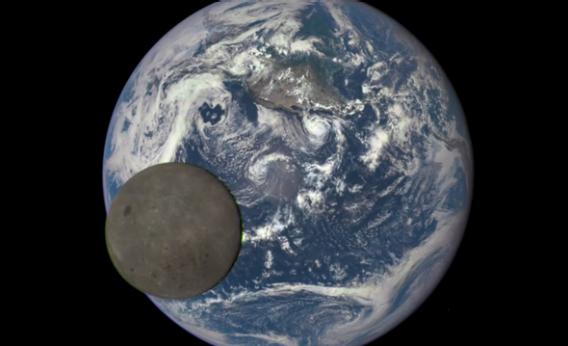Create a free profile to get unlimited access to exclusive videos, sweepstakes, and more!
An EPIC View of the Moon Transiting the Earth!

Just a few days ago I wrote about the DSCOVR satellite delivering gorgeous views of the Earth from space, but it just massively one-upped itself: Here’s an animation of the Moon passing in front of the Earth as seen by the satellite’s Earth Polychromatic Imaging Camera, or EPIC! And it’s even cooler than that: In the animation, you’re seeing the fully illuminated far side of the Moon!
Yegads.
The Deep Space Climate Observatory, or DSCOVR, was launched on a SpaceX Falcon 9 rocket in February. It was put into an orbit around the Sun that’s about 1.5 million kilometers smaller than Earth’s, in a direction toward the Sun. This region of space is called the first Lagrange point, or L1 point, and due to a quirk of gravity this is a stable configuration, like sitting in the trough between two hills. At this spot, DSCOVR points toward the Earth with the Sun behind the satellite, so it perpetually sees the sunlit day-side of the Earth. Update, Aug. 5, 2015: Oops! I meant to add a link to a description I did of Lagrange points, because they're cool. Also, technically, the L1 point is metastable, not stable; if nudged, an object there will fall away from the L1 point.
The Moon goes around the Earth once a month on an orbit tilted to the Earth’s orbit around the Sun. DSCOVR is four times farther away from the Earth than the Moon is, so it’s well outside the Moon’s orbit. Twice a year or so everything lines up just right, and Earth, Moon, and DSCOVR form a perfect line. If the timing is right, DSCOVR will then see the Moon pass directly in front of or behind the Earth, what astronomers call a transit.
In this case, with the Moon in front of the Earth, DSCOVR sees the Moon’s far side, the side always facing away from the Earth, where we landlubbers never see it. That gives the Moon an odd appearance, since there are fewer large dark features on the far side than the one we see.
Also, we tend to think of the Moon as being very bright, silvery, and shiny, but in fact the Moon’s surface is quite dark. At night, with nothing to challenge it, the Moon looks incredibly bright, but in reality the surface is quite gray. You can see that in the DSCOVR animation, too.
I’ll note this isn’t the first time we’ve seen such a transit from space; back in 2008 the EPOXI spacecraft took a very similar series of shots. This one is much higher resolution, of course, with everything looking much sharper. Here’s the EPOXI animation:
Still pretty neat. I’ve been interested in the DSCOVR mission for a long time, ever since Al Gore proposed it (as Triana) as a way to raise awareness of our planet and its environment. I think that’s a fantastic idea, and animations like this are a lovely and exciting bonus. Remember, that’s us down there, every single one of us on (and off) the planet.
We see the Moon moving across the sky all the time from Earth, and it’s a beautiful thing. But when we see it from space, from quite literally the other side, why, it takes on a new dimension, a new perspective, and becomes even more awe-inspiring. The clockwork of the heavens is a wonder to behold, and now we can see it from many angles. We’re a part of that mechanism, and I think that’s an excellent thing to be reminded of from time to time.


























